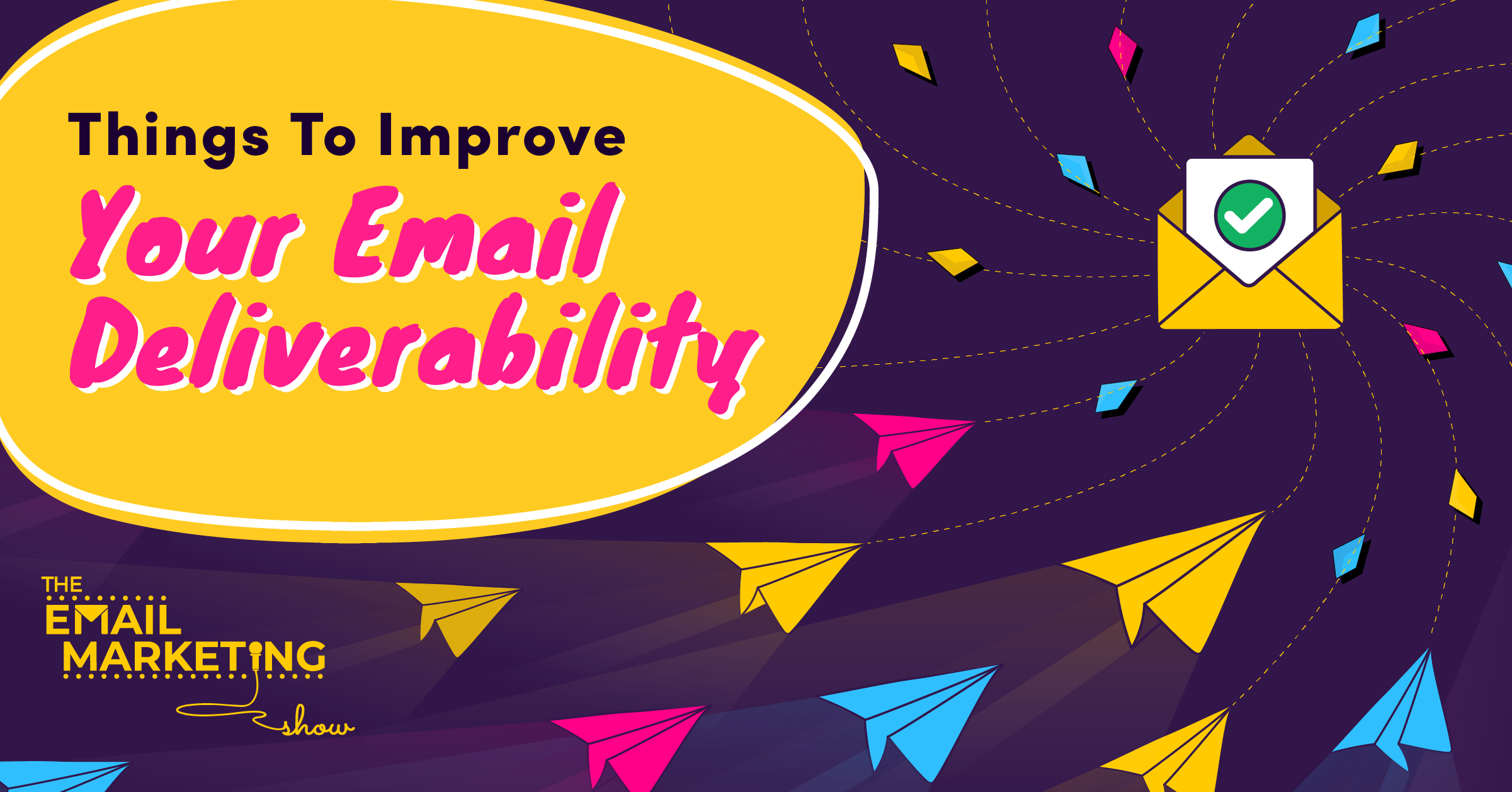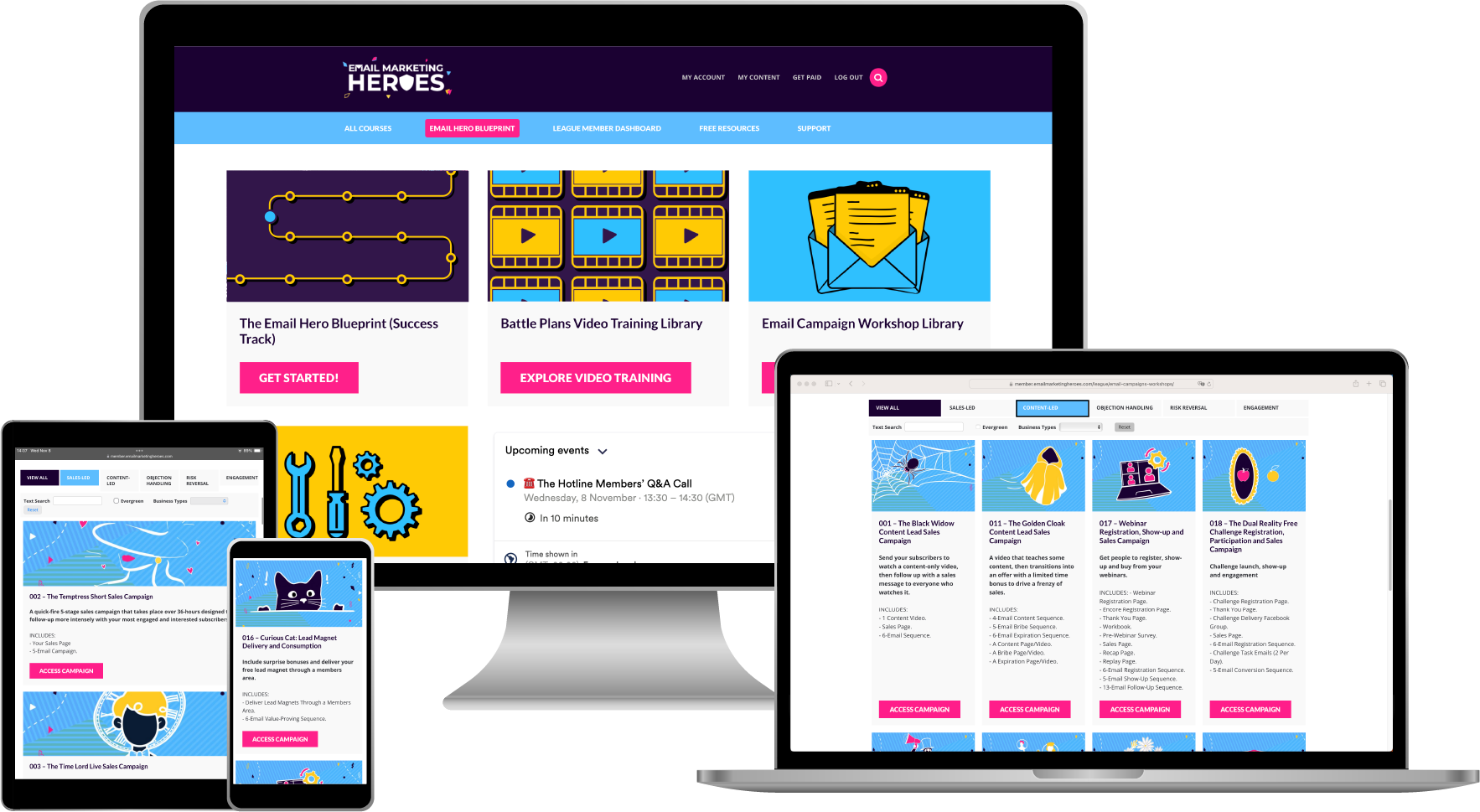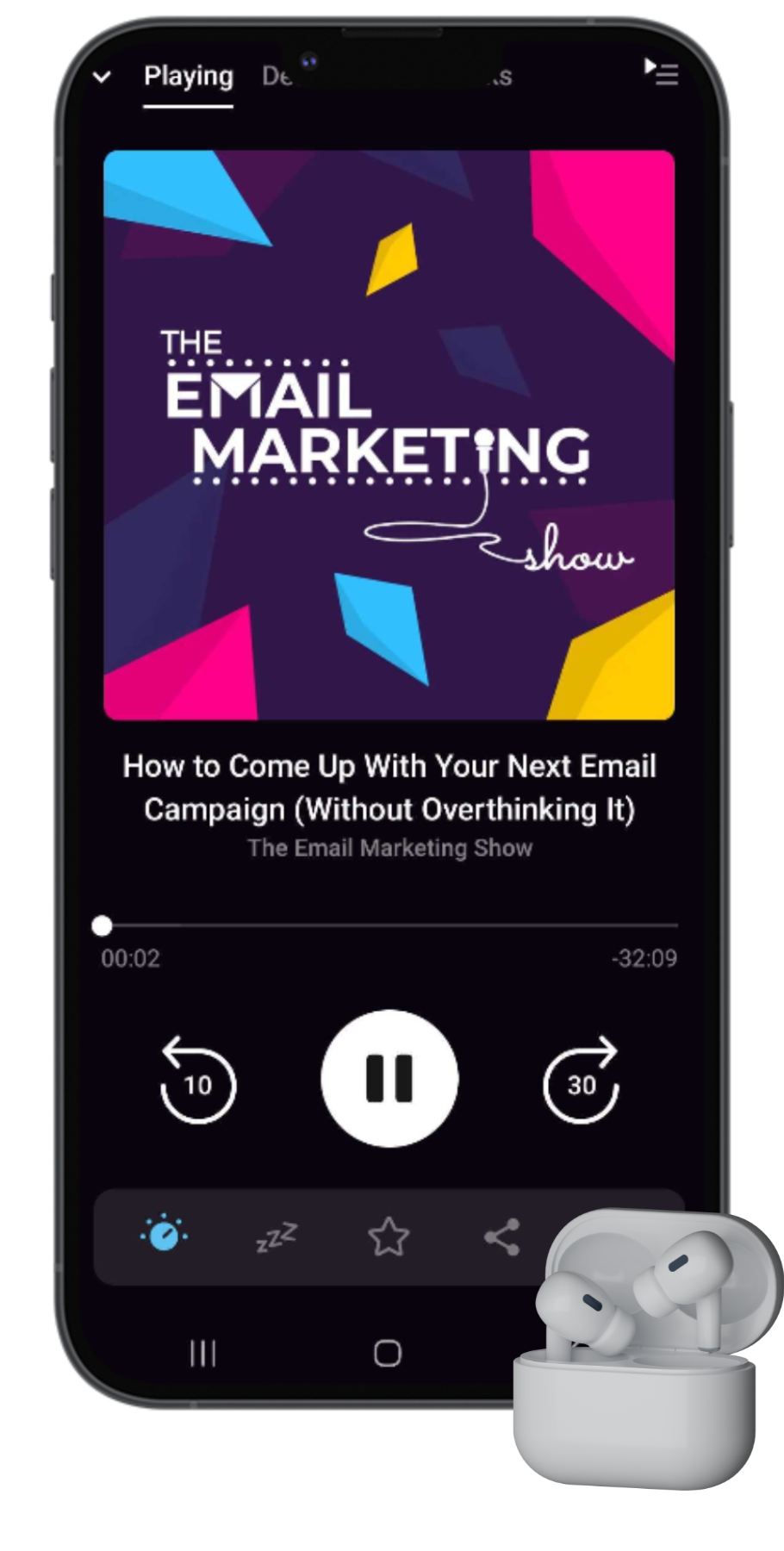
The Truth About All The Surprising Things That REALLY Impact Your Email Deliverability
How do you improve your email deliverability? What can damage your sender's reputation? How can you make sure your emails land in your subscribers' inboxes?
We're Kennedy and Carrie, and we're here to share the truth about all the surprising things that affect your email deliverability so you can have better results.
Ready?
SOME EPISODE HIGHLIGHTS: (0:33) Want to carry on with the conversation? Join our FREE Facebook group. (2:21) What is 'email deliverability'? (5:06) The technical things that impact your email deliverability. (7:40) Using too many images. (9:49) More reasons for not using too many images in your emails. (13:55) Having little or no engagement with your emails. (16:26) Using 'spammy' words. (21:00) What can you do to improve your email deliverability? (23:03) Keep your list clean. (24:57) Subject line of the week.
What is 'email deliverability'?
Let’s say this first – nothing will affect your deliverability like not sending enough emails! You can only improve your email deliverability if you send emails! No one gets them if you don’t send them, right?
With that said, when we talk about deliverability, we refer to the ability to get your emails into people’s primary inboxes so they can see them, open them, and click the links inside them to go and buy your products and services.
You can put great effort into learning how to write great emails with effective subject lines. But if your emails end up in people’s spam folders or are blocked altogether, you won't get any results with your email marketing. You need to ensure that your emails are delivered. So we're sharing the email best practices for you to bake into your everyday processes to improve your deliverability.
For this, we assume the people on your email list have chosen to be there. This means you haven't gone onto the Internet and scraped email addresses or bought an email list illegally. The premise of this advice is that you do the same email marketing we do – i.e. opt-in, permission-based marketing. In other words, someone’s seen a good reason (such as a lead magnet) to join your email list, and they've voluntarily given you their email address and permission to send them emails. Because if not, when people start receiving emails from someone they don't know, they'll be quick to hit the spam button.
The technical things that impact your email deliverability
Before you start emailing people, there are a few technical parameters you need to set up regardless of how big your list is or what niche you’re in. These are:
- SPF (Sender Policy Framework).
- DKIM (DomainKeys Identified Mail).
- And DMARC (Domain-based Message Authentication, Reporting, and Conformance).
We’re not going into detail, but we suggest you research how to set them up or hire someone to do it for you. All you need to know is that setting these values up helps validate your reputation as a sender to ensure your emails are delivered securely and consistently. These parameters verify you can legitimately send emails from your website. They're measures that exist to protect people, so don't skip this step.
If you’re in our Facebook group and have any doubts, come and ask. And if you are inside our programme, The Email Hero Blueprint, we have tech calls where we answer these types of questions.
So what else impacts your email deliverability?
1. Using too many images
Things such as using large images or GIFs in your emails might impact your deliverability. But that's if you use them all the time. Think of deliverability as a scoring system. Doing something ‘wrong' occasionally doesn't mean your email marketing is doomed! Most of the time, you'll be fine. You won't be immediately blacklisted and put in Gmail jail. Using images or GIFs here and there isn't going to hurt your deliverability if you're otherwise getting good engagement.
However, regularly putting lots of massive images in your emails (especially if they’re not compressed and end up being sent as attachments) isn’t great for your deliverability. For the most part, you want your emails to be text and links. And this isn’t just for email deliverability. It’s also (and mainly) because emails that are sent by people don’t have lots of graphics or heavy layouts – that’s what business emails look like. We want to fall into the category of personal relationships here. We want our subscribers to focus on what we mean by the words we use in the emails – not the images.
More reasons for not using too many images in your emails
Another reason not to use too many images is that you don't want people to disconnect from your message because of the images you use. Say you’re telling a story about an awful chair, and you attach a photo of it. Someone who might have the same chair (or happen to like the image of the one you shared) might be offended and not connect with what you're sharing. Instead, you want people to use their imagination and decide for themselves what ‘an awful chair’ looks like. Let the words paint the pictures for you.
Also, if you’re an e-commerce business that sells products, for example, you don’t want to put photos in your emails. The goal is for people to click on the links inside your emails, go to your website, see your products, and buy from there. Your emails have the job of getting people to click on your links. And people clicking on your links is a great indicator to Gmail that your emails generate engagement. So don’t give them everything in the email because if you do, they have no reason to click!
An exception to that rule (and one we sometimes use) is to put a preview image of a video in an email that tells people that by clicking on a link, they’ll be taken to a page where they can watch a video. In that preview image, we’ll often include something curious like a thumbnail or an animated GIF. But that doesn’t take away from driving the click.
Using images can also become a noble obstacle. If you’re waiting to publish an email because you first need to find the perfect image and then resize it etc., you may never send that email. And messy action is better than no action! So reduce friction wherever you can. Tell the story you want to share in the email, and let the sales page do the rest. Every additional thing you put in there can get in the way of people taking action.
2. Having little or no engagement with your emails
The next thing that affects email deliverability is the engagement of your emails. Are people paying attention? Are they opening your emails, clicking on the links, and replying?
Opening emails is a good sign to Google – it shows people are there and taking some form of action. But people clicking on the links in your emails is a stronger engagement signal. It tells Google that your subscribers are interested in what you do – your emails must be good!
The next best thing is people replying to your emails – that shows a greater level of human engagement. And while it's harder to get people to do this, forwarding your emails is an even better engagement signal. It tells Google that your content must be of great quality.
Something we do in our Super Signature at the bottom of our emails is to say something along the lines of “If someone forwarded this to you, make sure you also get the next email”. This plants the seed in the readers’ minds that they can forward your email to someone else if they find it valuable. It's also useful because you're telling people what the next step is – what do you want them to do now? If you want people to forward your emails, tell them. Because inherently people want to be helpful – they just don't know what's useful to you.
You can't generate engagement if you’re not emailing consistently or frequently enough. If you only show up out of the blue when you have something to sell, people are going to see through that. So don't be that person! If you haven’t sent emails in a while, don’t overthink it – just jump back in.

The Top 10 Books To 'Power Up' Your Email Marketing
10 book recommendations that will improve all areas of your email marketing (including some underground treasures that we stumbled upon which have been game-changing for us).
3. Using ‘spammy’ words
Another factor that may negatively impact your deliverability is using words and phrases that are picked up by scam software. A lot of email platforms automatically do spam checks. For example, we use Keap, and certain words and phrases are highlighted as spam. It might surprise you, but “Netflix” is one of them! So it's not just your traditional ‘naughty words'. If people mark emails as spam, and those emails have particular words or phrases in them, Gmail starts to pick them up as ‘spammy'.
However, let’s not forget deliverability works like a scoring system. If you generally have great engagement and a clean list, the occasional ‘spammy' word isn’t going to hurt your deliverability. If you have a low spam score, you could, for example, get away with using the word “free” in a subject line with no issues.
Think of your email marketing relationship with your audience as a friendship or even a dating relationship. You’re not expected to be perfect all the time! If you make one negative blip here and there, you’ll be forgiven.
Also, don't look at email subscribers as data – they are people. You’re emailing humans who have raised their hands and said they wanted to hear from you. If you get marked as spam by the occasional person, don’t focus on that too much. Instead, keep serving the people who showed up and want to hear from you.
What can you do to improve your deliverability score?
The first thing you can do to improve your deliverability score is to show up more often (i.e. increase the frequency of your emails). Think of your credit score. If you never had credit before, your score won't be good because the banks don't know if you'll pay the money back on time. The same goes for emails. You want Gmail and the other providers to have a track record for you so they can see your past reputation.
To do that, you need to build one. If you're not sending a great amount of emails, you’re not giving Gmail and the other platforms enough evidence about what type of sender you are. Gmail will want to know that when you send an email people open and click, reply, or forward, and generally don’t mark you as spam! So don’t be the person who only reaches out when you have a favour to ask (i.e. something to sell). People will be more likely to reach back when you’re showing up consistently.
Keep your list clean
Another thing you can do is to keep your list clean. Remove the people who are repeatedly not engaging with your email list. Before you do that, you can give them the chance to re-engage by putting them through a re-engagement campaign. But if they don't, take them off your list. If every time you send an email, lots of people on your list don’t look at your emails, Gmail interprets this as your emails not being good. And this negatively impacts your sender's reputation. So if someone hasn’t engaged with your emails in 60 days, give them a chance to re-engage. If they don't take it, unsubscribe them. This way, you'll be able to reach those who want to be reached.
If you want access to these (and more) strategies to keep your email deliverability high, check out the details of our programme, The Email Hero Blueprint.
Subject line of the week
This week’s subject line is “Low power kicks”. The email had a good click-through rate, and it was about the fact Kennedy has been training in Muay Thai for about 18 months. The story in the email used the metaphor that in business and life (just like when training), you don't want to be kicking hard the whole time. Sometimes you have to use low-power kicks instead. The metaphor makes the whole thing more interesting. And people get to learn more about you. This helps you build a more three-dimensional picture of a real human being who’s out there doing stuff. So check it out!
Useful Episode Resources
Related episodes
Master Your Metrics – Unleashing The Power Of Email Marketing Analytics.
How To Create THE Most Successful Re-Engagement Email Campaign (And Smash Your Sales Targets).
FREE list to improve your email marketing
If you want to write better emails, come up with better content, and move your readers to click and buy, here's how. Here's a list of our Top 10 most highly recommended books that will improve all areas of your email marketing (including some underground treasures that we happened upon, which have been game-changing for us). Grab your FREE list here.
Join the FREE Facebook group
Do you want to chat about how you can maximise the value of your email list and make more money from every subscriber? There's a way! Every business is different, so come and hang out in our FREE Facebook group, the Email Marketing Show Community for Course Creators and Coaches. You'll find a lot of training and resources, and you can talk about what you're up to.
Try ResponseSuite for $1
This content is sponsored by ResponseSuite.com, the survey quiz and application form tool that we created specifically for small businesses like you to integrate with your marketing systems to segment your subscribers and make more sales. Try it out for 14 days for just $1.
Join The Email Hero Blueprint
Want more? Let's say you're a course creator, membership site owner, coach, author, or expert and want to learn about the ethical psychology-based email marketing that turns 60-80% more of your newsletter subscribers into customers (within 60 days). If that's you, then The Email Hero Blueprint is for you.
This is hands down the most predictable, plug-and-play way to double your earnings per email subscriber. It allows you to generate a consistent sales flow without launching another product, service, or offer. Best news yet? You won't have to rely on copywriting, slimy persuasion, NLP, or ‘better' subject lines.
Want to connect with Carrie?
You can find Carrie on her website!
Subscribe and review The Email Marketing Show podcast
Thanks so much for tuning into the podcast! If you enjoyed this episode (all about the things that impact your email deliverability) and love the show, we'd appreciate you subscribing and leaving us a review of the show on your favourite podcast player.
Not only does it let us know you're out there listening, but your feedback helps us to keep creating the most useful episodes so more awesome people like you can discover the podcast.
And please do tell us! What do you really fill your working days with if you don't spend time on email marketing? We'd love to know!






